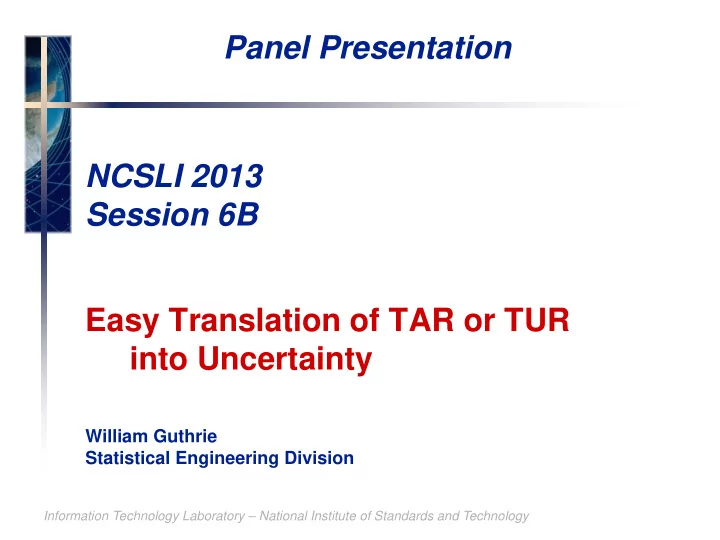

Panel Presentation NCSLI 2013 Session 6B Easy Translation of TAR or TUR into Uncertainty William Guthrie Statistical Engineering Division Information Technology Laboratory – National Institute of Standards and Technology
Generic Uncertainty Expression • Standard uncertainty for a measurement result from a calibrated measurement device can be generally expressed as ( ) ( ) ( ) = 2 + 2 u y u D u C n n where ( ) is the standard uncertainty of the measurement u D n ( ) is the standard uncertainty of the calibration u C n 1 Information Technology Laboratory – National Institute of Standards and Technology
Showing Next Level of Uncertainty • Expanding this formula to show the next level of uncertainty down the calibration chain gives ( ) ( ) ( ) = 2 + 2 u y u D u C n n ( ) ( ) ( ) = 2 + 2 + 2 u D u D u C − − n n 1 n 1 2 Information Technology Laboratory – National Institute of Standards and Technology
Assumptions • Next, assume – TAR or TUR ≥4 at each level of calibration, – systems are in place that mitigate the effects of any potential sources of uncertainty not accounted for in the TAR or TUR being used, and – the numerator and denominator of the TAR or TUR are approximately known multiples of the associated standard uncertainties • Example based on ANSI/NCSL Z540.3 TUR Upper Device Spec.- Lower Device Spec. = TUR Z 540.3 Upper 95% Cal. Unc.- Lower 95% Cal. Unc. ( ) ( ) ( ) ⋅ 6 u D u D u D 6 ≈ = ⋅ ≡ n n n r ( ) ( ) ( ) ⋅ k 4 u C 4 u C u C 3 Information Technology Laboratory – National Institute of Standards and Technology n n n use of 6/4 assumes approximate normality use of r k keeps results general
Relating Uncertainties at Different Levels ( ) ( ) u D u D ≥ ⇒ = ≥ n n TUR 4 r r 4 ( ) k k ( ) ( ) u C 2 + 2 u D u C n − − n 1 n 1 2 r u D ( ) ( ) ( ) ⇒ 2 ≥ 2 + 2 k u D u C − − n n 1 n 1 16 2 r u D ( ) ( ) ( ) ⇒ 2 − 2 − 2 ≥ k u D u C 0 − − n n 1 n 1 16 2 r u D ( ) ( ) ⇒ 2 − 2 ≥ k u D 0 − n n 1 16 4 Information Technology Laboratory – National Institute of Standards and Technology
Put These Expressions Together … ( ) ( ) ( ) ( ) = 2 + 2 + 2 u y u D u D u C − − n n 1 n 1 2 r u D ( ) ( ) ( ) ( ) ( ) ≤ 2 + 2 − 2 + 2 + 2 k u D u D u D u C − − − n n n 1 n 1 n 1 16 2 r ( ) ( ) ( ) = 2 + 2 + 2 k u D u D u C − n n n 1 16 5 Information Technology Laboratory – National Institute of Standards and Technology
… and Just Carry On … 2 r ( ) ( ) ( ) ( ) ≤ + + 2 2 2 k u y u D u D u C − n n n 1 16 2 r ( ) ( ) ( ) ( ) = 2 + 2 + 2 + 2 k u D u D u D u C − − n n n 2 n 2 16 2 2 2 r r ( ) ( ) ( ) ( ) ( ) ( ) ≤ + + − + + 2 2 2 2 2 2 k k u D u D u D u D u D u C − − − n n n n 2 n 2 n 2 16 16 2 2 2 r r ( ) ( ) ( ) ( ) = 2 + 2 + 2 + 2 k k u D u D u D u C − n n n n 2 16 16 6 Information Technology Laboratory – National Institute of Standards and Technology
… Until You End Up Here! Now we can just use ( ) i − 4 Device Accuracy 2 n 1 ( ) r ∑ ( ) ( ) = ≤ 2 u y k u y u D − n 2 16 16 r 3 = i 0 k for legacy systems with TAR or TUR ≥4. i ∞ 2 r ∑ ( ) ≤ 2 k u D n No further uncertainty 16 = i 0 analysis required! 2 16 r Similar results appear ( ) = < k u D if 1 − n to hold for systems 2 16 r 16 k based on EOPR as well. 7 Information Technology Laboratory – National Institute of Standards and Technology
Recommend
More recommend